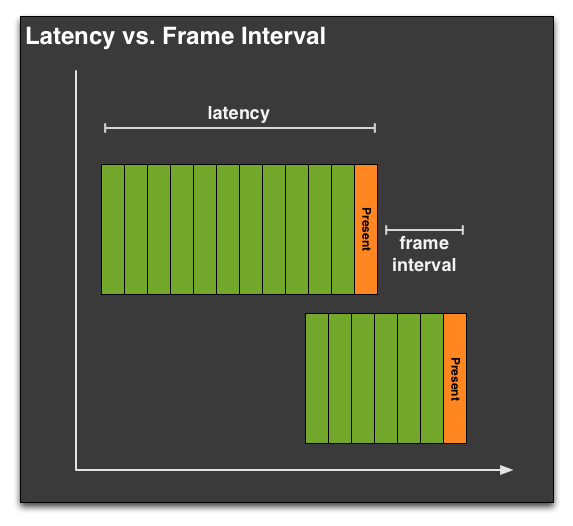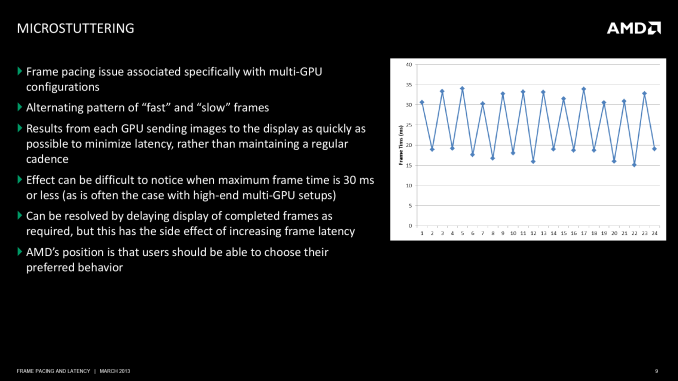AMD Frame Pacing Explored: Catalyst 13.8 Brings Consistency to Crossfire
by Ryan Smith on August 1, 2013 2:00 PM ESTIn Summary: The Frame Pacing Problem
Before we dive into the technical details of AMD’s frame pacing mechanism and our results, we’re going to spend a moment recapping the basis of the frame pacing problem. So if you haven’t been keeping up with this issue, please read on, otherwise feel free to jump a page.
In brief, in multi-GPU setups, be it single-card products like the GTX 690 or multiple cards such as a pair of 7970s, the primary mode of splitting up work is a process called Alternate Frame Rendering (AFR). In AFR, rather than have multiple GPUs working on a single frame, each GPU gets its own frame. This method has over time proven to be the most reliable method, as attempting to split up a single frame over multiple GPUs (with their relatively awful interconnect) has proven to be unreliable and difficult to get working. AFR in contrast is by no means perfect and has to deal with inter-frame dependency issues – where the next frame relies in part on the previous frame – but this is still easier to implement and more consistent than previous efforts at splitting frames.

However due to the mechanisms of AFR, left unattended it can significantly impact the intervals between frames and consequently whether stuttering is perceived. To do AFR well it’s necessary to pace the output of each GPU such that each GPU is delivering a rendered frame at as even a rate as possible; not too soon after the previous frame, and not too late such that the following frame comes up quickly. In a 2 GPU setup, which is going to be the most common, this means the second GPU needs to produce a finished frame when the first GPU is roughly half-way done with its current frame. Should this fail to happen then we have poorly paced frames that will result in perceived micro-stuttering.
Micro-stuttering has been a longstanding issue on multi-GPU setups. Both NVIDIA and AMD have worked on the issue to various degrees, but at the end of the day multi-GPU setups have never proven to be as reliable as single-GPU setups, which is why our editorial position on the matter has been to always favor single powerful GPUs over multiple GPUs when at all possible. Consequently it’s impractical to fully solve micro-stuttering and achieve frame pacing consistency on level with single-GPU setups, but it’s still possible to improve on previous methods and achieve a level of frame pacing that is reasonably effective and “good enough” for most needs. This is what AMD has been focusing on for the past few months.
Moving on, how AMD ended up in this situation is effectively the combination of three factors. The first of course being the innate technical challenged posed by AFR, while the second and third factors have been a poorly realized position on lag vs. consistency and a failure of competitive analysis respectively.
On the former, AMD’s position up until now has been that they’ve favored minimizing input lag in their designs. If you need to hold back a frame to better pace it, then you are by definition introducing some input lag, a quality that is generally undesirable to a user base that usually avoids mechanisms like v-sync for that reason. AMD’s position hasn’t been wrong of course, but it has come at the exclusion of allowing a bit of input lag to better manage frame pacing. AMD’s decision then has been to lighten up on this position and dedicate the resources to deal with both approaches. AMD would introduce advanced frame pacing as an optional control, while leaving the simpler, less laggy approach as another option.
Meanwhile the story with competitive analysis is far less complex. Simply put, AMD wasn’t testing for frame pacing as part of their standard competitive analysis, so when these results first broke AMD was caught flat-footed. This is a business failure rather than a technical failure, which makes it easy enough to resolve. But it’s also the reason why AMD needed time to develop an advanced frame pacing mechanism, as they had never seen the need to develop one before.
Ultimately this is a problem that should have never happened, and it is unfortunate that AMD let it come to this. At the same time however we believe it’s never too late for redemption, and AMD has been making all of the right moves to try to achieve that. They have been clear about their failures and shortcomings, including their frustrations that they’ve left performance on the table by not looking for these issues, and they have been equally clear in laying out a plan for how they would go about fixing all of this. So today we will finally get to see first-hand whether AMD’s initial efforts for resolving frame pacing in multi-GPU setups has paid off.











102 Comments
View All Comments
Feellia - Friday, August 2, 2013 - link
Not aimed at anyone, but flat out in any competitive game play the kind that has tourneys and pays out cash, Mostly fps such as quake..etc everyone has vsync off it flat out adds input lag...all the pros turn it off no matter what monitor is used, but no one is running a SLI/CrossfFire set up during these events.The pros typically lower settings quite damn low so they can push a steady 125fps and screen tearing is absolutely no concern. And if i have vsync on my aim % takes a nearly 25% dip
Anyway this is review is about duel+ cards, and kudos to AMD even though they still need a bit of work before going on a official non beta release = )
piwo - Friday, August 2, 2013 - link
can you check a10- 5750m with hd6670?dew111 - Friday, August 2, 2013 - link
I just got a second HD 7950, and this driver makes a HUGE difference! They should have done this earlier, but their timing was great for my first CrossFire setup :PJamesWoods - Sunday, August 4, 2013 - link
It's a crying shame they won't jump back to HD 4000 series or even HD 3000 series and fix these problems. I'm sure there is still quite a large loyal fanbase using these cards. I happen to own several systems with HD 4850's in them, and they can still set pace on a lot of modern games. Crossfire is another story. They never really felt optimized running in X fire.medi02 - Tuesday, August 6, 2013 - link
Is it me, or does nVidia have much lower min fps on a number of charts? =)transphasic - Tuesday, August 6, 2013 - link
Well done, AMD! You didn't bother to do anything about creating fixes for the single GPU setup, and basically ignored those w/o CF setups.You had 2 1/2 months without any new driver fixes, and THIS is the BEST you can do?
Major fail once again.
Thanks for nothing....
medi02 - Wednesday, August 7, 2013 - link
Exactly which single GPU setup is giving you micro stuttering problem?usrevenge - Wednesday, August 7, 2013 - link
Basically, AMD did a lot to fix the problems, but still leaves a lot of work to be done. I call these drivers a success.Nearox - Monday, August 26, 2013 - link
Does this technology also apply to the HD6000 series (and in particular the HD6950)? Could anyone say if this will also work for Skyrim? Thinking about getting a 2nd hand hd6950 to go xfire with this, seeing the good results from this AnandTech test.lopper - Wednesday, August 28, 2013 - link
A question: Does this driver fix stuttering on dual graphics configurations like A10 +6670?